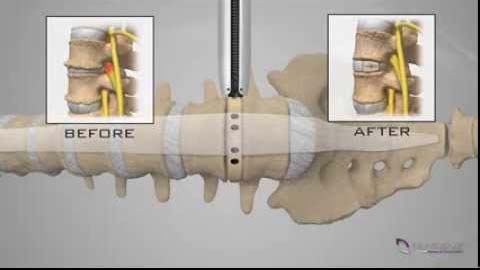XLIF (Extreme Lateral Lumbar Interbody Fusion) is a new technique that allows lateral arthrodesis. It is an innovation with respect to previous techniques that use anterior and posterior approaches.
How is the XLIF technique?
The patient lies on his side on the couch in the operating room. The surgeon makes two small incisions. For one, enter the instrument that will progress until it reaches the disk. The other incision serves to guide and separate the muscular planes from the sac that contains the abdominal viscera (peritoneum). There are surgeons who do everything with the same incision.
The first instrument that is introduced gives electrical stimuli to detect the presence of nerves in its advance. It is the way to avoid and not damaging nerve tissues. An electromyography device is used with this mission. The surgeon also uses X-rays to reach the disc. Once on the disc, the guide is used to add tubes that expand the entranceway.
Subsequently, the surgeon uses an expander that converts the guide into a cylinder for us to understand. In this way, being hollow, a clamp is introduced inside this tube that takes you to the disk to be able to extract it. Once the disc is removed, the implant or box is inserted into the disc space. This box is filled with a graft to facilitate the fusion of the two vertebral bodies.
The ultimate goal is for a consolidation of the bone to occur and the two vertebrae to become one, so to speak. While consolidation occurs, in some cases a clamping system must be added. This can be done in two ways. In the same surgery, a plate can be screwed to the vertebral bodies. Another method is, in a second time, to put pedicle bars and screws through a posterior approach.

What advantages does the XLIF technique provide?
The best advantage of XLIF is that it does not attach to the posterior musculature during surgery. The major drawback of the posterior pathways is the damage suffered by the lumbar extensor musculature, which is so important for lumbar stability. With this technique, this musculature is not touched and will have the ability to recover completely. This makes recovery better and less likely that chronic pain persists.
It is a little aggressive technique with the tissues of the spine so it has less bleeding and recovery is better. It is likely that we can get up before bed and spend less time admitted.
You might also want to read: What is a Transforaminal Lumbar Interbody Fusion (TLIF)?

